Understanding the OHS Amendment Bill 2020 and CEO Responsibilities
The content discusses the OHS Amendment Bill 2020, focusing on the responsibilities of chief executive officers (CEOs) outlined in different sections of the bill compared to the current OHS Act. It delves into the proposed changes, delegation of duties, and the importance of interpreting statutes. The text emphasizes the need for CEOs to ensure the proper discharge of employer duties and highlights key considerations in the legislative process.
- OHS Amendment Bill
- CEO responsibilities
- Legislative interpretation
- Statutory appointment
- Workplace safety
Download Presentation

Please find below an Image/Link to download the presentation.
The content on the website is provided AS IS for your information and personal use only. It may not be sold, licensed, or shared on other websites without obtaining consent from the author. Download presentation by click this link. If you encounter any issues during the download, it is possible that the publisher has removed the file from their server.
E N D
Presentation Transcript
Advocate Raynard Looch Klass Looch Associates The OHS Amendment Bill 2020 Back to the Drawing Board ! raynard@klasslooch.com www.klasslooch.com I d rather have people who challenge the law .Thank you for the tremendous role & impact SAIOSH & individuals are making & challenges they make to DEL . Phumi Maphaha Chief Inspector 10/06/2022
Agenda Section 16 Proposed section 16(3) Statutory Appointment (SAIOSH Technical Committee) Reasonably Practicable (Sections 8, 9, 10, 10(4) & 13) The Inspector s Report / Sections 31 & 32 The Constitution. Section 33 of the Bill of Rights. Promotion of Administrative Justice Act (PAJA) Industrial Health Resource Group and others v Minister of Labour & others [2015] (GP) Section 37B of the draft OHS Amendment Bill. Criminal Liability Administrative Fines
Current OHS Act. Section 16. Chief executive officer charged with certain duties (1) Every chief executive officer shall as far as reasonably practicable, ensure that the duties of his employer as contemplated in this Act, are properly discharged. (2) Without derogating from his responsibility or liability in terms of subsection (1), a chief executive officer may assign any duty contemplated in the said subsection, to any person under his control, which person shall act subject to the control and directions of the chief executive officer. chief executive officer", in relation to a body corporate or an enterprise conducted by the State, means the person who is responsible for the overall management and control of the business of such body corporate or enterprise.
Draft 1993 OHS draft Bill. Section 16. Chief executive officer charged with certain duties (1) Every chief executive officer shall as far as reasonably practicable, ensure that the duties of his employer as contemplated in this Act, are properly discharged. (2) Without derogating from his responsibility or liability in terms of subsection (1), a chief executive officer may delegate, including the power of further delegation, any duty contemplated in the said subsection, to any person under his control, which person shall act subject to the control and directions of the chief executive officer. Why was this draft changed? Delegate is rigid. Assign has no legal baggage. Delegare non delegatus potest. A person to whom something has been delegated cannot delegate further, i.e. one to whom powers and duties have been entrusted cannot entrust them to another. Interpretation of Statutes. What was the intention of legislator? The current OHS Act must be interpreted with its draft as guidance.
Draft OHS Amendment Bill. Section 16 15(1) A CEO shall ensure, as far as is reasonably practicable, that the duties of his or her employer as contemplated in this Act, are properly discharged. (1A) The CEO shall develop, implement and continuously review the health and safety management system as the employer may be directed in terms of section 7(1); (2) Without derogating from his or her responsibility or liability in (1A), a CEO may in writing, delegate any duty contemplated in the said subsections, to any person under his or her control, which person shall act subject to the control and direction of the CEO, in the interest of occupational health and safety; (2A) A person so delegated in terms of subsection (2) may not further delegate the duty to any other person."; and DEL maintains only the Direct Reports can be delegated i.t.o. section 16(2) of the Act / Bill.
SAIOSH Technical Committee proposes the inclusion of Section 16(3) Section 16(3). Except where specific written appointments are prescribed in terms of any regulation promulgated in terms of the Act and without derogating from his or her liability or responsibility or liability in terms of section 16(1) and section 16(2), a chief executive officer or a person appointed in terms of section 16(2) of the Act may in writing, appoint one or more competent persons to assist in discharging their duties as envisaged in the Act in the interests of occupational health and safety . The rationale behind this proposal is to address the vacuum currently experienced as regards so-called statutory appointments. Save where written appointments are required in terms of the regulations e.g. General Machinery Regulations and Construction Regulations, the Bill is silent on managerial and supervisory appointments that cascade down and closer to the realities of the workplace.
Managers and supervisors are an integral and essential part of an employer s health and safety management system and deserve statutory recognition. The CEO and 16(2) appointed persons are often too far removed from the realities of the workplace to properly discharge their statutory duties without managerial and supervisory assistance, resulting in employers having to resort to so-called in-house appointments - often labelled Section 16(2) Assistants, section 8(2) appointments and section 8(2)(i) (supervisory) appointments. While it can be argued that these so-called in-house appointments carry the same weight in law as the so-called statutory appointments since they constitute a lawful order as envisaged in section 14(c) of the Act, managers and supervisors should be given statutory status along the lines of the construction regulations. A statutory appointment does increase potential criminal liability. It formulises reality & creates a structure.
This proposal aligns with the Mine Health & Safety Act & Construction Regulations where provision is made for managerial and supervisory statutory appointments. Section 8 does also not provide for appointments and merely contains the duties of employers to their employees. The UK legislation also recognises the importance of such devolved statutory appointments where, in the equivalent of section 8, it reads: 7.(1) Every employer shall appoint one or more competent persons to assist him in undertaking the measures he needs to take to comply with the requirements and prohibitions imposed upon him by or under the relevant statutory provisions. (3) The employer shall ensure that the number of persons appointed under paragraph (1), the time available for them to fulfil their functions and the means at their disposal are adequate having regard to the size of his undertaking, the risks to which his employees are exposed and the distribution of those risks throughout the undertaking . (SA must take cognisance of international developments / legislation).
MHS Act EMPLOYER / OWNER [Section 2] OTHER PERSON [Section 7(2)] OTHER PERSON [Section 4] CEO BOARD MEMBER [Section 2A(3)] [Section2A] MANAGER [Section 3] SUBORDINATE MANAGERS [2.6.1 2.6.2] ENGINEER 2500 kws (2.13.1) MINE OVERSEER (2.14.1) (UNDERGROUND 300) COMPETENT PERSON (less than 2500Kw) ANOTHER PERSON [Section 7(3)] SHIFT BOSS (2.15.1 2.15.4) CHIEF SAFETY OFFICER SUBORDINATE ENGINEERS (2.13.3) 2 SAFETY OFFICERS (2.17.1) (300 EMPLOYEES
Construction Regulations 2014 CEO 16(1) 16(2) PC / Contractor Direct Report CR 8(1) Appointed by 16(2) CR 8(1) CR 8(2) Appointed by 16(2) CR 8(2) CR 8(7) / 8(8) Appointed by Con Manager / 8(8) by 16(2) CR 8(7) / 8(8) CR 8(5) Appointed by 16(2) CR 8(5)
SAIOSH Proposed Section 16 Structure CEO 16(1) 16(2) Direct Report 16(3) read with section 8 Manager 16(3) read with section 8 Manager 16(3) Manager 16(3) Manager 16(3) Manager 16(3) Manager 16(3) Supervisor read with section 8(2(i) 16(3) Supervisor read with section 8(2)(i)
General duties of employers to their employees. Section 8 (1) Every employer shall provide and maintain, as far as is reasonably practicable, a working environment that is safe and without risk to the health of his or her employees. (a) conducting a workplace specific risk assessment and thereafter developing and implementing a risk management plan in writing, in respect of every risk identified; (b) ensuring that the workplace specific risk assessment is conducted, by a person or persons who are competent to pronounce on all the risks associated with that workplace; (c) ensuring that the workplace specific risk management plan is in place and is available at the workplace when requested by an inspector . Reasonably practicable retained in section 8(1) but deliberately removed in section 8(2) subsections & sections 9, 10, 13 & 16.
Amendment of section 9 of Act 85 of 1993 General duties of employers and self-employed persons to persons other than their employees. Section 9 of the principal Act is hereby amended "(1) Every employer shall conduct [his] an undertaking in such a manner [as] to ensure [,as far as is reasonably practicable that persons other than those in his employment who may be directly affected by his activities are not thereby exposed to hazards to their health or safety] that the risk posed by identified hazards to persons other than those in the direct employ of the organisation who may be directly affected by the organisation s activities are not thereby exposed to hazards to their health or safety and the risk is managed in line with the risk management plan contemplated in section 8(2)(a). Why are duties tempered with reasonably practicable ?It aligns with Lex non cogit ad impossibilia. It means the law does not compel a man to do anything impossible or to do something which he cannot possibly perform. Reasonably practicable reflects & aligns with the common law. Only the Constitutional Court can change the common law!
Amendment of section 10 of Act 85 of 1993 General duties of Manufacturers & others regarding articles & Substances for use at work. 10. Section 10 of the principal Act is hereby amended (1) Any person who designs, manufactures, imports, sells , leases or supplies any article for use at work shall ensure, [as far as is reasonably practicable,] that (a) the article is safe and without risks to occupational health and safety when properly used; (b) the article is accompanied by the instructions which include precautionary measures to be adhered to; and (c) [that] it complies with all the prescribed requirements. . Reasonably practicable remains in the section 21 of the MHS Act. Manufacturer's and supplier's duty for health and safety.
Section 10(4) omitted in the Bill?! Equivalent retained in section 21(2) of the MHS Act & draft MHS Amendment Bill 2022. Section 10 (4) Where a person designs, manufactures, imports, sells or supplies an article or substance for or to another person and that other person undertakes in writing to take specified steps sufficient to ensure, as far as is reasonably practicable, that the article or substance will comply with all prescribed requirements and will be safe and without risks to health when properly used, the undertaking shall have the effect of relieving the first-mentioned person from the duty imposed upon him by this section to such an extent as is reasonable having regard to the terms of the undertaking. In (s.6(8)) of the UK Act, a person may rely on a written undertaking by another person to ensure the safety of an item.
Section 22. Sale of certain articles prohibited. (Retained in the Bill) Subject to the provisions of section 10(4),??? if any requirement in respect of any article, plant, machinery and safety equipment or for the use or application thereof has been prescribed, no person shall sell or market in any manner whatsoever such article, substance, plant, machinery or health and safety equipment unless it complies with that requirement. Section 41 of the Bill. This Act not affected by agreements [Save for the provisions of sections 10(4) and 37(2),] a provision of this Act shall not be affected by any term or condition of any agreement, whether such agreement was entered into before or after the commencement of this Act or before or after the imposition of any such condition, as the case may be. Impact? Employers will no longer be able to legally outsource certain statutory duties e.g. GSR 2A (Intoxication) i.t.o. a 37(2) Written Agreement. Section 37(2) retained in the Bill.
Statutory Defense Reasonably Practicable. (The Bill retains the definition??). "reasonably practicable" means practicable having regard to (a) the severity and scope of the hazard or risk concerned; (b) the state of knowledge reasonably available concerning that hazard or risk and of any means of removing or mitigating that hazard or risk; (c) the availability and suitability of means to remove or mitigate that hazard or risk; and (d) the cost of removing or mitigating that hazard or risk in relation to the benefits deriving therefrom. Why do you retain in the Bill the definition only to omit reference to it?? Every country that the SAIOSH T. C. researched retained reasonably practicable plus it s embraced by LAC. If the cost is prohibitive or no suitable means is available to mitigate / remove a risk, lex non cogit ad impossibilia applies.
By omitting the words reasonably practicable which is universally accepted as a yardstick to judge whether an employer has properly discharged his or her duties, the Bill appears to venture into the area of strict liability which has been consistently rejected by criminal courts including the Constitutional Court and SCA. Strict liability infers that an employer may be convicted of contraventions in the absence of the fault element (culpa or negligence). In 1997 the Constitutional Court ruled that in SA the principle of strict liability infringes negatively on the right to a fair trial provided for in section 35(3) of the Constitution, as well as with the right to freedom and security of the person provided for in section 12(1) of the Constitution.
Strict liability has no place in occupational health and safety legislation where negligence or culpa is the fault element as opposed to intention or dolus. By omitting the terms reasonably practicable , employers may not be able to argue: That the severity and scope of the hazard or risk concerned was a consideration in determining whether employers discharged their statutory duties. The availability and suitability of means to remove or mitigate that hazard or risk and the cost of removing or mitigating that hazard or risk in relation to the benefits deriving therefrom. The Chief Inspector refers to the definition in his presentation of the Bill? The definition remains defined in section 1 of the Bill & is also retained in some regulations. The definition is also in the MHS Act & retained in the draft MHS Amendment Bill 2022. Sloppy law-writing or an agenda? Nulla poena sine culpa.
Pikitup (SOC) Limited v South African Municipal Workers' Union obo members and others [2014] (LAC) = SCA in status) Sections 8 and 9 therefore place a duty on the employer to act proactively to avoid any harm or injury to its employees and others. There is no standard as to what is reasonably practicable. Each case will have to be determined on its own facts and circumstances. As can be seen from the definition of reasonably practicable it involves weighing different considerations from risk evaluation, means of removing or avoiding the risk, resource availability and a cost-benefit analysis. In Edwards v National Coal Board, Lord Justice Asquith stated: "Reasonably practicable as traditionally interpreted, is a narrower term than 'physically possible' and implies that a computation must be made in which the quantum of risk is placed in one scale and the sacrifice, whether in money, time or trouble involved in the measure necessary to avert the risk is placed in the other; and that, if it is shown that there is a gross disproportion between them, the risk being insignificant in relation to the sacrifice, the person upon who the duty is laid discharges the burden of proving that compliance was not reasonably practicable."
Amendment Bill. Section 31. Investigations An inspector [may] shall investigate the circumstances of any incident which has occurred at or originated from a workplace or in connection with the use of plant or machinery which has resulted, or in the opinion of the inspector could have resulted, in the injury, illness or death of a person. (But only disablement is criminalised? Section 37B) Amendment Bill. Section 32. Formal Inquiries The chief inspector may, and shall when so requested, by a person (?) producing prima facie evidence of an offence appoint a presiding inspector to conduct a formal inquiry into any incident which has occurred at or originated from a workplace or in connection with the use of plant or machinery which has resulted, or in the opinion of the chief inspector could have resulted in injury, illness or death of any person. (There usually is prima facie evidence of an offence post an incident unless caused by vis major / casus fortuitus / Act of God). E.g. Earthquake / tsunami / floods / meteors etc.).
Section 31. Investigations. Inspectors Report. (Bill). The Inspector shall submit a copy of the report, statements and documents to the provincial control inspector within whose area of jurisdiction such incident occurred , who will, after consultation with the chief inspector, submit the report to the National Prosecution Authority. Section 32 Formal Inquiry. Inspector s Report. (Bill). The evidence given at any inquiry under this section shall be recorded and a copy thereof shall be submitted by the presiding inspector together with his or her report to the chief inspector, and in the case of an incident in which or as a result of which any person died or was seriously injured (disabled?) or became (seriously?) ill, the presiding inspector shall submit a copy of the said evidence and the report to the chief inspector. The chief inspector shall submit the report to the National Prosecuting Authority within whose area of jurisdiction such incident occurred, within 90 days of the conclusion of the inquiry. These amendments sadly make no provision for employers & interested parties (upon request) to be furnished with a copy of the inspector s report & has been ruled to be unlawful.
MHS Act. Section 72. Inquiry records and reports (1) A person presiding at an inquiry must - (a) record the evidence given at the inquiry, including any evidence given with the assistance of an interpreter. At the conclusion of the inquiry, prepare a written report of the findings, recommendations and any remedial steps. Submit a copy of the report and the record of the inquiry to the Chief Inspector of Mines, (d) supply a copy of the report and the record of the inquiry to the employer and to any health and safety representative, health and safety committee or registered trade union that requested the inquiry; and on request, supply a copy of the report and the record of the inquiry to any person who has a material interest in the inquiry.(Family / Interested Parties). Retained in Bill 2020. The Chief Inspector of Mines must direct an inspector to conduct an (formal) inquiry into any accident or occurrence at a mine that results in the death of any person. Family of deceased are informed & may attend and cross examine witnesses. Retained MHS Bill 2022.
Industrial Health Resource Group and others v Minister of Labour and others [2015] (GP) (The Paarl Print Fire). It is declared that the persons referred to in section 32(5)(c) of the OHSA are entitled, on request to the presiding inspector, to be furnished with a copy of the report contemplated in section 32(9) of OHSA, into any inquiry held in terms of section 32 of OHSA. It is declared that the policy of the DEL to refuse access to a section 32 inquiry report in all instances and without regard to the circumstances of each case once the report is referred to the NPA is inconsistent with OHSA, the Promotion of Access to Information Act 2 of 2000, and the Constitution of the RSA and is accordingly unlawful and invalid . The NPA refused to prosecute despite prima facie evidence / damning findings by the former Chief Inspector / Presiding Officer against many companies / persons involved in the project.?? For a copy visit the link below. NPA promised an inquest but it never happened? I submit this verdict applies to section 31 Investigations as well. http://klasslooch.com.www77.jnb2.host-h.net/Industrial- Health-Resource-Group-and-others-v-Minister-of-Labour-and-others-2015/
The Grayston Bridge Collapse. The deviations from Form-Scaff's sketch weakened the structure to such an extent that it could not withstand the force of the wind on the afternoon it collapsed. That is why it collapsed, DEL found . City Press. Visit http://klasslooch.com.www77.jnb2.host-h.net/The-Grayston-Bridge-Collapse/ for media extracts of the leaked Inspector s Report. .
The Grayston Bridge Collapse report has been kept under wraps until now. DEL has refused to release the report, but the Johannesburg Development Agency (JDA) provided it to City Press on request, because it is in the public interest. According to the report, the MRC (Murray & Roberts Construction) entrusted the project to a candidate engineer, as site engineer and to the contract manager. Both were inexperienced and lacked the expertise for this specific project. The candidate engineer should have worked under the supervision of a registered (ECSA) engineer who had experience in building bridges or erecting temporary structures. Some of the other deviations include: At the median support, in the middle of the highway, which the entire structure effectively rested on, 21 of 33 diagonal supports had been left out. On both the east and the west side of the highway, reinforcements to the scaffolding were omitted. The deviations from Form-Scaff s sketch weakened the structure to such an extent that it could not withstand the force of the wind on the afternoon it collapsed. That is why it collapsed, the department found .
DEL still refuses to furnish Inspectors Report in this 2018 matter. Insists on PAIA. Civil suits for damages are impacted. Transparency? Openness?
The Constitution. Section 33 of the Bill of Rights. Just administrative action. 1. Everyone has the right to administrative action that is lawful, reasonable and procedurally fair. 2. Everyone whose rights have been adversely affected by administrative action has the right to be given written reasons. 3. An administrative action means any decision taken, or any failure to take a decision, by- a) an organ of state, when- 4. i) exercising a power in terms of the Constitution or a provincial constitution; or 5. ii) exercising a public power or performing a public function in terms of any legislation.
Promotion of Administrative Justice Act No. 3 of 2000 (PAJA) PREAMBLE WHEREAS section 33(1) and (2) of the Constitution provides that everyone has the right to administrative action that is lawful, reasonable and procedurally fair and that everyone whose rights have been adversely affected by administrative action has the right to be given written reasons. IN ORDER TO * promote an efficient administration and good governance; and * create a culture of accountability, openness and transparency in the public administration or in the exercise of a public power or the performance of a public function, by giving effect to the right to just administrative action.
The Inspector's Report & PAJA Definitions 1. (i) administrative action means any decision taken, or any failure to take a decision, by an organ of state, when exercising a power in terms of the Constitution or a provincial constitution; or (ii) exercising a public power or performing a public function in terms of any legislation. (Investigations / Inquiries i.t.o. the OHS Act) Reasons for administrative action. 5. (1) Any person whose rights have been materially and adversely affected by administrative action and who has not been given reasons for the action may, within 90 days after the date on which that person became aware of the action or might reasonably have been expected to have become aware of the action, request that the administrator concerned furnish written reasons for the action. (Inspector s Report)
(2) The administrator to whom the request is made must, within 90 days after receiving the request, give that person adequate reasons in writing for the administrative action. (3) If an administrator fails to furnish adequate reasons for an administrative action, it must, subject to subsection (4) and in the absence of proof to the contrary, be presumed in any proceedings for judicial review that the administrative action was taken without good reason. (4) (a) An administrator may depart from the requirement to furnish adequate reasons if it is reasonable and justifiable in the circumstances and must forthwith inform the person making the request of such departure. How do employers / persons know if there is an adverse finding if DEL refuses to furnish them with the Report? How is it that DEL can ignore the Constitution, PAJA & High Court decisions regarding the Inspector's Report??
OHS Amendment Bill. Criminal Liability 37B. (1) An employer, chief executive officer, manager?, agent? or employee commits an offence by contravening or failing to comply with a provision of this Act, thereby causing a person s- (a) death; (New homicide offence?) (Elements?) (b) permanent disablement; (non-permanent disabling injury is now not an offence but is subject to a section 31 Investigation?) or (c) illness. (How serious?) (2) The chief executive officer, manager, agent or employer of the employee commits an offence by performing or omitting to perform an act, if the act or omission falls within the scope of the authority or employment of the employer or employee concerned. Repeals section 38(2) of the OHS Act which punishes negligent injury. Does this create a new homicide offence outside the common law crime of culpable homicide? Only the NPA can recommend such a charge. Can DEL now recommend homicide charges?
Managers are mentioned in section 37B under the heading Criminal Liability without any previous reference to managers (or definition) elsewhere in the Bill. The addition of section 16(3) will cure this issue. An employer, chief executive officer, a person envisaged in section 16(3), agent or employee commits an offence by contravening or failing to comply with a provision of this Act, thereby causing a person s- (a) death; (We already have a common law homicide crime). (b) injury or (c) serious illness. This aligns with the current MHS Act. The MHS Amendment Bill 2020 introduces a similar statutory homicide provision. Barring the OHS & MHS Amendment Bills, no other criminal statute interferes with the common law crime of culpable homicide. I predict the superior courts won t be happy ..
"Administrative fines 37A. (1) If a person commits a breach of this Act, the inspector may by written notice to that person impose an administrative fine in accordance with Schedule 2. (Note the Chief Inspector s new take on this?) (2) An administrative fine may, instead of a criminal prosecution, be imposed on a person who becomes liable to prosecution for any breach of this Act. (3) An inspector shall serve a copy of the written notice on the employer, self-employed person or person who conducts a business or undertaking concerned. (4) The amount of the fine stipulated in the notice may not exceed the amount (a) prescribed for the offence; and (b) which a court would presumably have imposed in the circumstances. (5) An administrative fine imposed shall be paid to the Director-General of DEL on or before a date stated in the notice referred to in that subsection.
Administrative fines Schedule 2 Column 1 Column 2 Maximum fine Section contravened 7 Health and Safety policy. Not a universal requirement. R 50 000 R 50 000 19 (1); Health and safety committees 20 (4); An employer shall take the prescribed steps to ensure that a health and safety committee complies with the provisions of section 19(4) R 50 000 R 50 000 21; General prohibitions 24(1);(2) Reporting of incidents R 25 000 25; Medical practitioners duty to occupational disease R 50 000 29(3); Functions of Inspectors??????? R 25 000 30(6) Improvement / Correction Notice R50 000
MAXIMUM FINES OR PERIOD OF IMPRISONMENT THAT CAN BE IMPOSED FOR OFFENCES. SCHEDULE 1 Column 1 Column 2 Section under which convicted Maximum fine and period of imprisonment 2B Huh? R 1 000 000 or 3 years imprisonment 8 9 10 ???????? 12 13 (hazard conversancy) ??? 14 (Employees better start saving)! 15 16 ???????? 17 (1) ; 17 (4) 18 (3) 22 30 (2) 31(1B) 34 36 37 38 40 41 42 R 5 000 000 or 5 years imprisonment R 5 000 000 or 5 years imprisonment R 1 000 000 or 3 years imprisonment R 1 000 000 or 3 years imprisonment R 200 000 or 2 years imprisonment R 1 000 000 or 3 years imprisonment R 1 000 000 or 3 years imprisonment R 1 000 000 or 3 years imprisonment R 1 000 000 or 3 years imprisonment R 1 000 000 or 3 years imprisonment R 500 000 or 3 years imprisonment R 500 000 or 3 years imprisonment R 1 000 000 or 3 years imprisonment R 5 000 000 or 5 years imprisonment R 500 000 or 3 years imprisonment R 5 000 000 or 5 years imprisonment R 5 000 000 or 5 years imprisonment R 1 000 000 or 3 years imprisonment R 1 000 000 or 3 years imprisonment R 1 000 000 or 3 years imprisonment
SECTION 43 REGULATIONS Penalties. (Draconian???) A regulation may in respect of any contravention thereof or failure to comply therewith, prescribe a penalty of a fine to a maximum of R5 000 000.00 or imprisonment for a period not exceeding 12 months, and, in the case of a continuous offence, not exceeding an additional fine of R200 or additional imprisonment of one day for each day on which the offence continues: Provided that the period of such additional imprisonment shall not exceed 90 days or five years or both. Regulations, as opposed to sections of an Act, are promulgated by the Minister without Parliament s oversight / input. It is irrational to equate the penalties for regulation contraventions with that of (sections) an Act. Regulations traditionally carry less weight in law with lesser penalties.
Where is the much trumpeted Right to Leave a dangerous Workplace ???? Does the Bill align with the Constitution / PAJA? Does the Bill align with international developments? Does the Bill align with the (post Constitutional) 1996 MHS Act? The Gold Standard of post Constitutional OHS legislation? Is there an agenda with the deliberate omission of reasonably practicable ? Is it rational for regulation penalties to be the same as those for section contraventions? There are many other flaws in the Bill . BACK TO THE DRAWING BOARD


![RE: ELECTORAL MATTERS AMENDMENT BILL [ B42-2023]](/thumb/18837/re-electoral-matters-amendment-bill-b42-2023.jpg)

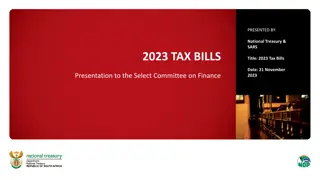
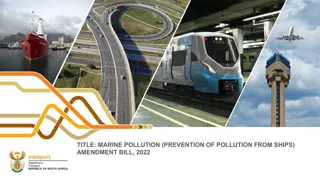
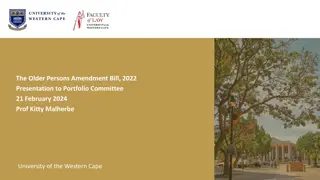

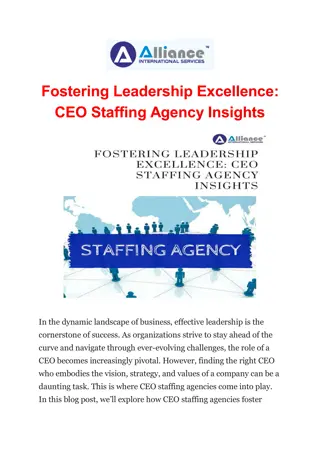
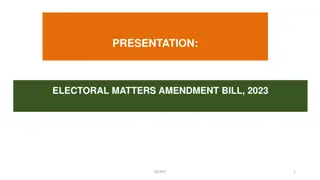



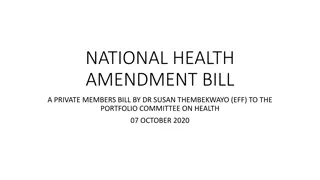

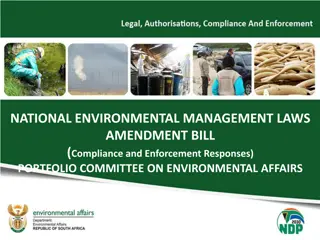
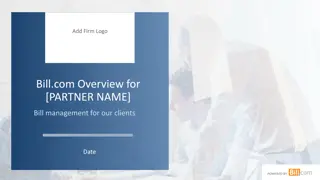
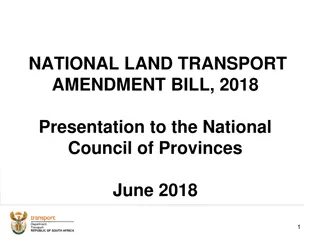
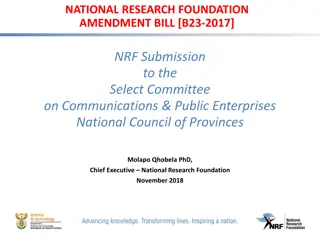
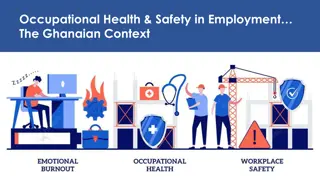
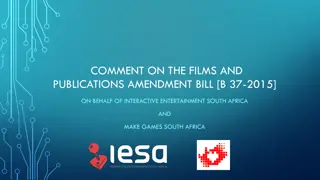
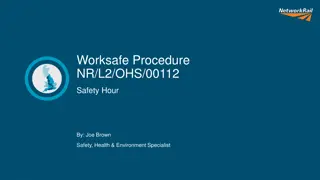
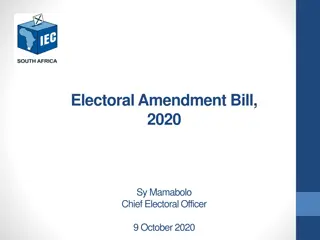
![Briefing on the Criminal Procedure Amendment Bill [B12-2021] to the Portfolio Committee on Justice and Correctional Services](/thumb/157093/briefing-on-the-criminal-procedure-amendment-bill-b12-2021-to-the-portfolio-committee-on-justice-and-correctional-services.jpg)